PONTIAC G3 2010 Owners Manual
Manufacturer: PONTIAC, Model Year: 2010, Model line: G3, Model: PONTIAC G3 2010Pages: 368, PDF Size: 3.94 MB
Page 151 of 368
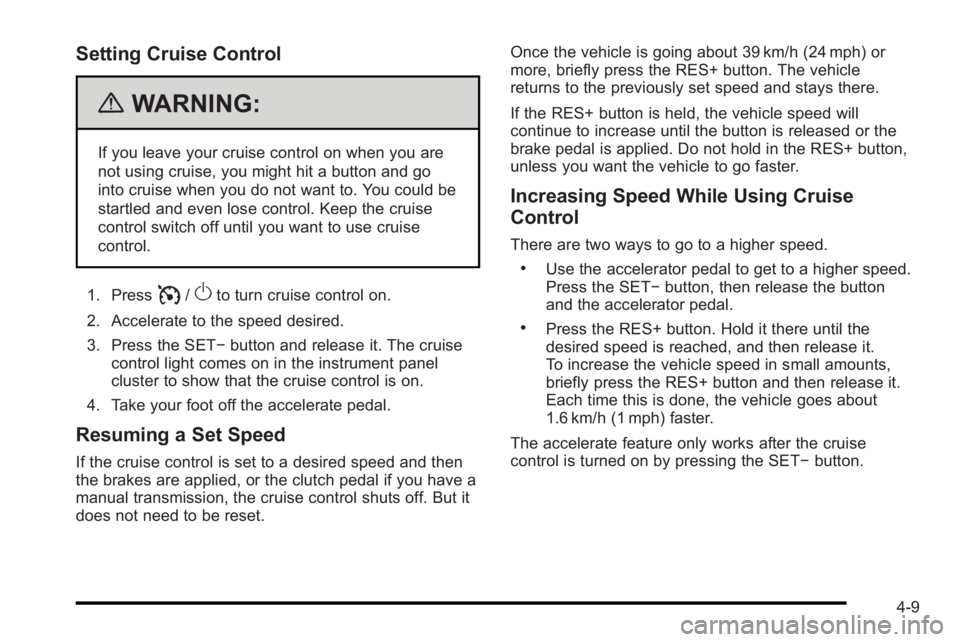
Setting Cruise Control
{WARNING:
If you leave your cruise control on when you are
not using cruise, you might hit a button and go
into cruise when you do not want to. You could be
startled and even lose control. Keep the cruise
control switch off until you want to use cruise
control.
1. Press
I/Oto turn cruise control on.
2. Accelerate to the speed desired.
3. Press the SET− button and release it. The cruise
control light comes on in the instrument panel
cluster to show that the cruise control is on.
4. Take your foot off the accelerate pedal.
Resuming a Set Speed
If the cruise control is set to a desired speed and then
the brakes are applied, or the clutch pedal if you have a
manual transmission, the cruise control shuts off. But it
does not need to be reset. Once the vehicle is going about 39 km/h (24 mph) or
more, briefly press the RES+ button. The vehicle
returns to the previously set speed and stays there.
If the RES+ button is held, the vehicle speed will
continue to increase until the button is released or the
brake pedal is applied. Do not hold in the RES+ button,
unless you want the vehicle to go faster.
Increasing Speed While Using Cruise
Control
There are two ways to go to a higher speed.
.Use the accelerator pedal to get to a higher speed.
Press the SET−
button, then release the button
and the accelerator pedal.
.Press the RES+ button. Hold it there until the
desired speed is reached, and then release it.
To increase the vehicle speed in small amounts,
briefly press the RES+ button and then release it.
Each time this is done, the vehicle goes about
1.6 km/h (1 mph) faster.
The accelerate feature only works after the cruise
control is turned on by pressing the SET− button.
4-9
Page 152 of 368
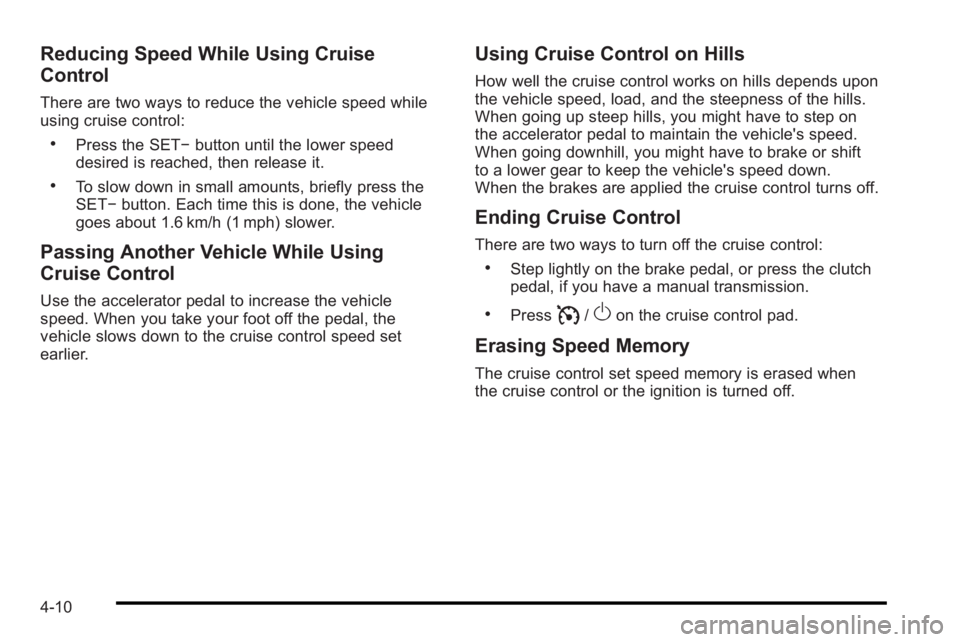
Reducing Speed While Using Cruise
Control
There are two ways to reduce the vehicle speed while
using cruise control:
.Press the SET−button until the lower speed
desired is reached, then release it.
.To slow down in small amounts, briefly press the
SET− button. Each time this is done, the vehicle
goes about 1.6 km/h (1 mph) slower.
Passing Another Vehicle While Using
Cruise Control
Use the accelerator pedal to increase the vehicle
speed. When you take your foot off the pedal, the
vehicle slows down to the cruise control speed set
earlier.
Using Cruise Control on Hills
How well the cruise control works on hills depends upon
the vehicle speed, load, and the steepness of the hills.
When going up steep hills, you might have to step on
the accelerator pedal to maintain the vehicle's speed.
When going downhill, you might have to brake or shift
to a lower gear to keep the vehicle's speed down.
When the brakes are applied the cruise control turns off.
Ending Cruise Control
There are two ways to turn off the cruise control:
.Step lightly on the brake pedal, or press the clutch
pedal, if you have a manual transmission.
.PressI/Oon the cruise control pad.
Erasing Speed Memory
The cruise control set speed memory is erased when
the cruise control or the ignition is turned off.
4-10
Page 153 of 368

Exterior Lamps
Uplevel shown, Base similar
The lever on the left side of the steering column
operates the exterior lamps.
The exterior lamp band has three positions:
3 (Headlamps) : Turns on the headlamps, together
with the following:
.Taillamps
.License Plate Lamp
.Instrument Panel Lights
.Parking Lamps
The headlamps automatically turn off when the ignition
key is turned to LOCK/OFF or ACC/ACCESSORY. ;
(Parking Lamps) : Turns on the parking lamps,
together with the taillamps, license plate lamp, and
instrument panel lights.
OFF : Turns all the lamps off, except the Daytime
Running Lamps (DRL).
Daytime Running Lamps (DRL)
Daytime Running Lamps (DRL) can make it easier for
others to see the front of your vehicle during the day.
Fully functional daytime running lamps are required on
all vehicles first sold in Canada.
The DRL system makes the headlamps come on when
the following conditions are met:
.The ignition is on.
.The exterior lamp band is in OFF or in the parking
lamp position.
.The parking brake is released.
An indicator light on instrument panel cluster comes on
when the DRL system is on.
When the DRL system is on, the taillamps, sidemarker
lamps, parking lamps and instrument panel lights do not
come on unless the exterior lamps control is turned to
the parking lamp or headlamp position.
4-11
Page 154 of 368

The DRL system turns off when one of the following
conditions are met:
.The ignition is off.
.The parking brake is on.
.The high-beam headlamps are on.
.The low-beam headlamps are on.
.The flash-to-pass feature is used.
The regular headlamp system should be used when
needed.
Fog Lamps
For vehicles with fog lamps, they are controlled by
the
#band located on the middle of the turn signal/
multifunction lever.
To use the fog lamps, the ignition must be turned to
ON/RUN and the low-beam headlamps or parking
lamps must be on.
Turn the band to
#to turn the fog lamps on. The band
automatically returns to its starting position when
released. The fog lamp indicator light comes on in the
instrument panel cluster. See Fog Lamp Light
on
page 4‑33.
To turn the fog lamps off, turn the band to
#again.
The fog lamp indicator light will go off. The fog lamps will also turn off when the high-beam
headlamps are turned on. When the high-beam
headlamps are turned off, the fog lamps will turn on
again.
Some localities have laws that require the headlamps to
be on along with the fog lamps.
Instrument Panel Brightness
This feature controls the brightness of the instrument
panel lights.
The thumbwheel for this feature is located on the
instrument panel to the left of the steering column.
Turn the thumbwheel to brighten or dim the lights.
4-12
Page 155 of 368
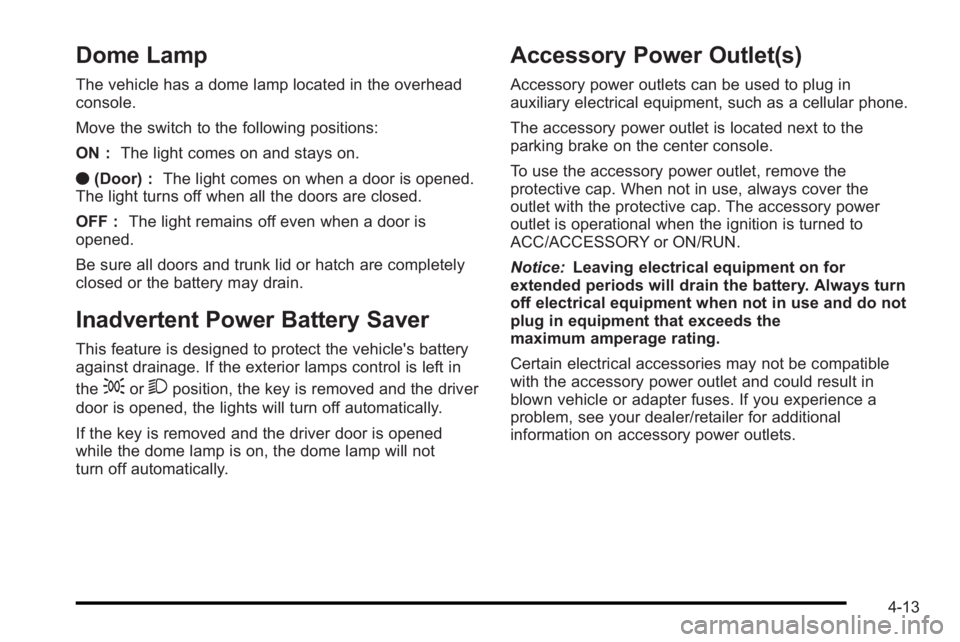
Dome Lamp
The vehicle has a dome lamp located in the overhead
console.
Move the switch to the following positions:
ON :The light comes on and stays on.
O (Door) : The light comes on when a door is opened.
The light turns off when all the doors are closed.
OFF : The light remains off even when a door is
opened.
Be sure all doors and trunk lid or hatch are completely
closed or the battery may drain.
Inadvertent Power Battery Saver
This feature is designed to protect the vehicle's battery
against drainage. If the exterior lamps control is left in
the
;or2position, the key is removed and the driver
door is opened, the lights will turn off automatically.
If the key is removed and the driver door is opened
while the dome lamp is on, the dome lamp will not
turn off automatically.
Accessory Power Outlet(s)
Accessory power outlets can be used to plug in
auxiliary electrical equipment, such as a cellular phone.
The accessory power outlet is located next to the
parking brake on the center console.
To use the accessory power outlet, remove the
protective cap. When not in use, always cover the
outlet with the protective cap. The accessory power
outlet is operational when the ignition is turned to
ACC/ACCESSORY or ON/RUN.
Notice: Leaving electrical equipment on for
extended periods will drain the battery. Always turn
off electrical equipment when not in use and do not
plug in equipment that exceeds the
maximum amperage rating.
Certain electrical accessories may not be compatible
with the accessory power outlet and could result in
blown vehicle or adapter fuses. If you experience a
problem, see your dealer/retailer for additional
information on accessory power outlets.
4-13
Page 156 of 368
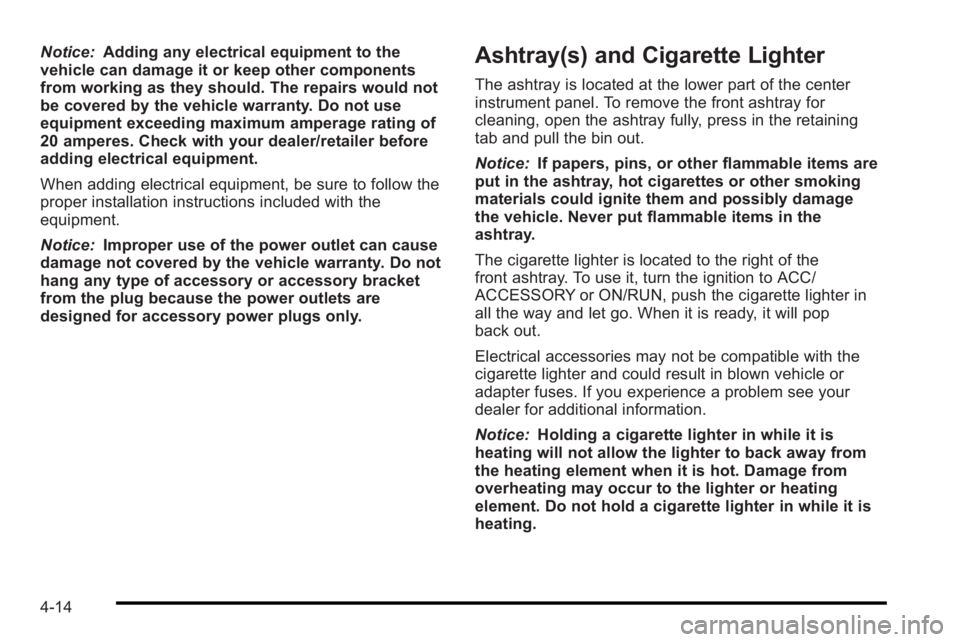
Notice:Adding any electrical equipment to the
vehicle can damage it or keep other components
from working as they should. The repairs would not
be covered by the vehicle warranty. Do not use
equipment exceeding maximum amperage rating of
20 amperes. Check with your dealer/retailer before
adding electrical equipment.
When adding electrical equipment, be sure to follow the
proper installation instructions included with the
equipment.
Notice: Improper use of the power outlet can cause
damage not covered by the vehicle warranty. Do not
hang any type of accessory or accessory bracket
from the plug because the power outlets are
designed for accessory power plugs only.Ashtray(s) and Cigarette Lighter
The ashtray is located at the lower part of the center
instrument panel. To remove the front ashtray for
cleaning, open the ashtray fully, press in the retaining
tab and pull the bin out.
Notice: If papers, pins, or other flammable items are
put in the ashtray, hot cigarettes or other smoking
materials could ignite them and possibly damage
the vehicle. Never put flammable items in the
ashtray.
The cigarette lighter is located to the right of the
front ashtray. To use it, turn the ignition to ACC/
ACCESSORY or ON/RUN, push the cigarette lighter in
all the way and let go. When it is ready, it will pop
back out.
Electrical accessories may not be compatible with the
cigarette lighter and could result in blown vehicle or
adapter fuses. If you experience a problem see your
dealer for additional information.
Notice: Holding a cigarette lighter in while it is
heating will not allow the lighter to back away from
the heating element when it is hot. Damage from
overheating may occur to the lighter or heating
element. Do not hold a cigarette lighter in while it is
heating.
4-14
Page 157 of 368
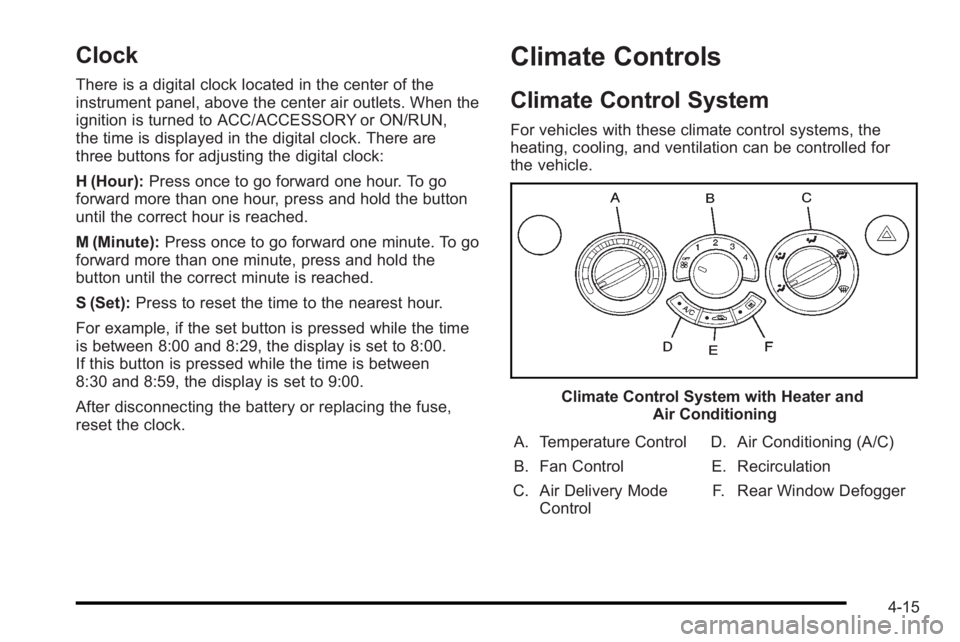
Clock
There is a digital clock located in the center of the
instrument panel, above the center air outlets. When the
ignition is turned to ACC/ACCESSORY or ON/RUN,
the time is displayed in the digital clock. There are
three buttons for adjusting the digital clock:
H (Hour):Press once to go forward one hour. To go
forward more than one hour, press and hold the button
until the correct hour is reached.
M (Minute): Press once to go forward one minute. To go
forward more than one minute, press and hold the
button until the correct minute is reached.
S (Set): Press to reset the time to the nearest hour.
For example, if the set button is pressed while the time
is between 8:00 and 8:29, the display is set to 8:00.
If this button is pressed while the time is between
8:30 and 8:59, the display is set to 9:00.
After disconnecting the battery or replacing the fuse,
reset the clock.
Climate Controls
Climate Control System
For vehicles with these climate control systems, the
heating, cooling, and ventilation can be controlled for
the vehicle.
Climate Control System with Heater and Air Conditioning
A. Temperature Control
B. Fan Control
C. Air Delivery Mode Control D. Air Conditioning (A/C)
E. Recirculation F. Rear Window Defogger
4-15
Page 158 of 368

Climate Control System with Heater Only
A. Temperature Control
B. Fan Control
C. Air Delivery Mode Control D. Rear Window Defogger
E. Outside Air/Recirculation
OFF : Turns the fan off.
Temperature Control : Turn clockwise or
counterclockwise to increase or decrease the
temperature of the air flowing from the system.
9 (Fan Control) : Turn clockwise or counterclockwise
to increase or decrease the fan speed. The fan must be
turned on to run the air conditioning compressor. Air Delivery Mode Control :
Turn clockwise or
counterclockwise to change the current airflow mode.
Select from the following air delivery modes:
Y (Vent) : Air is directed to the instrument panel
outlets.
\ (Bi-Level) : Air is divided between the instrument
panel and floor outlets.
[ (Floor) : Air is directed to the floor outlets, with
some air directed to the rear outlets. Keep the area
under the front seats clear to allow the flow of air to the
rear compartment.
É(Defog) : This mode clears the windows of fog or
moisture. Air is directed to the windshield, floor, and
side window outlets. When this mode is selected, the
system automatically runs the air-conditioning. To defog
the windows faster, turn the temperature control to the
warmest setting.
1 (Defrost) : This mode quickly clears the windshield
of fog or frost. Air is directed to the windshield and side
window outlets. When this mode is selected, the system
automatically runs the air-conditioning. To defrost the
windows faster, turn the temperature control to the
warmest setting.
Do not drive the vehicle until all the windows are clear.
4-16
Page 159 of 368

A/C (Air Conditioning) :For vehicles with air
conditioning, follow these steps to use the system.
Turn
9to the desired speed. The air conditioning does
not operate when the fan control knob is in the off
position. Press A/C to turn the air conditioning on and
off. When A/C is pressed, an indicator light comes on to
show that the air conditioning is on.
For quick cool down on hot days, do the following:
1. Open the windows to let hot air escape.
2. Press
?.
3. Press A/C.
4. Select the coolest temperature.
5. Select the highest
9speed.
Using these settings together for long periods of time
may cause the air inside of the vehicle to become too
dry. To prevent this from happening, after the air in the
vehicle has cooled, turn the recirculation mode off.
The air conditioning system removes moisture from the
air, so a small amount of water might drip under the
vehicle while idling or after turning off the engine.
This is normal. ?
(Recirculation) : This mode recirculates and helps
to quickly cool the air inside the vehicle. It can be used
to prevent outside air and odors from entering the
vehicle.
For vehicles with a recirculation button, press the button
to turn the recirculation mode on. An indicator light
comes on to show that the recirculation is on. Press the
button again to return to outside air mode.
For vehicles with a lever, move the lever to choose the
recirculation mode.
Using the recirculation mode for extended periods may
cause the windows to fog. If this happens, select the
defrost mode.
: (Outside Air) : This mode brings outside air into
the vehicle.
For vehicles with a recirculation button, press the button
until the recirculation mode is turned off. The vehicle
then returns to the outside air mode.
For vehicles with a lever, move the lever to choose the
outside air mode.
4-17
Page 160 of 368
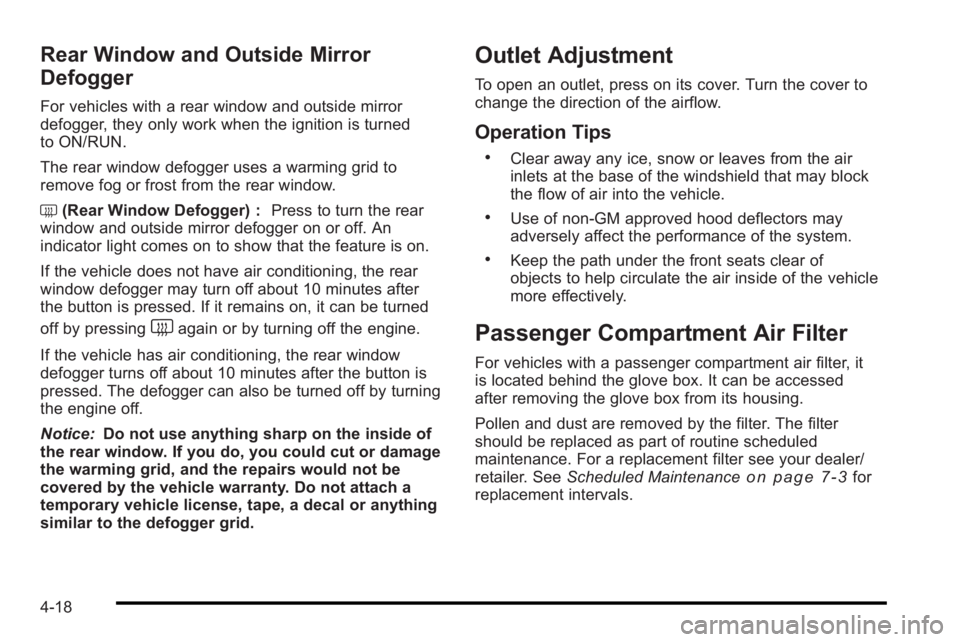
Rear Window and Outside Mirror
Defogger
For vehicles with a rear window and outside mirror
defogger, they only work when the ignition is turned
to ON/RUN.
The rear window defogger uses a warming grid to
remove fog or frost from the rear window.
<(Rear Window Defogger) : Press to turn the rear
window and outside mirror defogger on or off. An
indicator light comes on to show that the feature is on.
If the vehicle does not have air conditioning, the rear
window defogger may turn off about 10 minutes after
the button is pressed. If it remains on, it can be turned
off by pressing
defogger turns off about 10 minutes after the button is
pressed. The defogger can also be turned off by turning
the engine off.
Notice: Do not use anything sharp on the inside of
the rear window. If you do, you could cut or damage
the warming grid, and the repairs would not be
covered by the vehicle warranty. Do not attach a
temporary vehicle license, tape, a decal or anything
similar to the defogger grid.
Outlet Adjustment
To open an outlet, press on its cover. Turn the cover to
change the direction of the airflow.
Operation Tips
.Clear away any ice, snow or leaves from the air
inlets at the base of the windshield that may block
the flow of air into the vehicle.
.Use of non-GM approved hood deflectors may
adversely affect the performance of the system.
.Keep the path under the front seats clear of
objects to help circulate the air inside of the vehicle
more effectively.
Passenger Compartment Air Filter
For vehicles with a passenger compartment air filter, it
is located behind the glove box. It can be accessed
after removing the glove box from its housing.
Pollen and dust are removed by the filter. The filter
should be replaced as part of routine scheduled
maintenance. For a replacement filter see your dealer/
retailer. See Scheduled Maintenance
on page 7‑3for
replacement intervals.
4-18